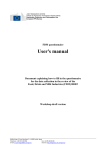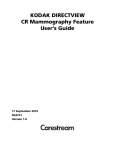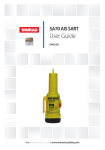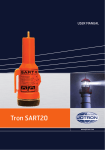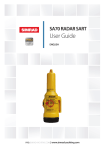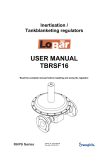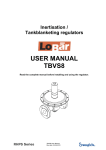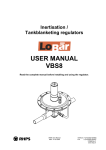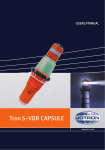Download User`s manual
Transcript
JOINT RESEARCH CENTRE Institute for Prospective Technological Studies (IPTS) Sustainable Production and Consumption Unit European IPPC Bureau WT questionnaire User's manual Document explaining how to fill in the questionnaire for the data collection in the review of the Waste Treatment (WT) BREF June 2014 Edificio Expo, C/ Inca Garcilaso, 3 – 41092 Seville, Spain Telephone: +34-95 44 88 284 Fax: +34-95 44 88 426 E-mail: [email protected] Internet: http://eippcb.jrc.ec.europa.eu/ Review of the WT BREF - Questionnaire user's manual 1 INTRODUCTION 3 2 GENERAL INSTRUCTIONS 3 3 STRUCTURE AND CONTENT OF THE QUESTIONNAIRE 4 3.1 3.2 3.3 3.4 3.5 3.6 3.7 3.8 3.9 3.10 3.11 3.12 3.13 "WASTE TREATMENT ACTIVITY" SHEET "WASTE INPUT" SHEET "OUTPUT" SHEET SHEETS ON CHARACTERISATION "STORAGE AND COMMON STEPS" SHEET "PROCESS – MECHANICAL" SHEET "PROCESS – BIOLOGICAL" SHEET "PROCESS – PHYSICO-CHEMICAL" SHEET "EMISSIONS TO AIR" SHEET "EMISSIONS TO WATER" SHEET "WATER CONSUMPTION" SHEET "RAW MATERIALS CONSUMPTION" SHEET "ENERGY CONSUMPTION" SHEET 5 6 6 7 7 7 7 7 8 8 9 9 9 4 HOW MANY QUESTIONNAIRES SHOULD BE PROVIDED 5 THE KEY ROLE OF THE "WASTE TREATMENT ACTIVITY" SHEET 9 16 6 IMPACT OF WASTE INPUT AND OUTPUT ON PLANT/INSTALLATION ENVIRONMENTAL PERFORMANCES 16 7 17 7.1 DESCRIPTION OF FGT AND WWT PLANTS HOW TO REFLECT THE EXISTENCE OF SYSTEMS SHARED WITH OTHER PARTS OF THE INSTALLATION 17 8 WASTE TREATMENT EFFICIENCY IN THIS QUESTIONNAIRE 18 9 BAT CANDIDATES 18 9.1 ECONOMIC DATA 19 10 PRACTICALITIES FOR THE USE OF THE QUESTIONNAIRE 19 10.1 PRINTING THE QUESTIONNAIRE 10.2 ATTACHING ADDITIONAL FILES TO THE QUESTIONNAIRE 10.3 ADDITIONAL EXPLANATIONS 19 20 20 11 21 2 GLOSSARY June 2014 EIPPCB/WT BREF Questionnaire User's Manual 1 INTRODUCTION The primary purpose of the questionnaire is to collect data to derive the Best Available Technique (BAT) conclusions for the revised version of the WT BREF. In consideration of the key environmental issues of the industrial sector (identified at the KOM and by means of the filled-in templates sent by TWG members), this questionnaire is focused on the emission levels with a view to deriving the BAT-associated emission levels (BAT-AELs). Especially for emissions to air and water, additional information on how the data are obtained is imperative for deriving meaningful conclusions. Questions included in the questionnaire have been proposed/revised/selected by the TWG members, taking into consideration the importance of the data requested for the WT BREF review process, as well as the availability of the data (and the time the operator will need to provide the data). A considerable amount of work has been done to ensure the clarity of the required information through these instructions and tooltips given for several fields. 2 GENERAL INSTRUCTIONS The questionnaire should be completed on a personal computer equipped with Microsoft Excel. Please use the proposed drop-down menus and predefined options wherever possible; free text fields are available throughout the questionnaire to provide further explanations (Comments or additional information fields). When filling in the fields, the values must not be inserted by expanding the series (i.e. it is not recommended to use the drag&drop built-in Excel feature). The zooming embedded Excel function can be used to magnify specific questionnaire sections. Detailed instructions and guidance are provided within the tooltips attached to most of the questions. When answering the questions, please always read the corresponding tooltips (hover the mouse over the question) to check how the data should be provided (sometimes, the questionnaire allows you to provide data in different formats): If the provided data are estimated (i.e. not based on measurements performed during the reference year), please indicate that this is the case in the 'Comments' cell in the corresponding sheet. Some data may not be available, so in this case please use the abbreviation 'NA' or leave the field empty and indicate the reason in the comments fields. If some data are available but cannot be presented in the format specified in the questionnaire, the corresponding cell should also be marked 'NA' and you should report this in the 'Comments' cell. Please note that according to Directive 2010/75/EU on Industrial Emissions (IED), emission levels associated with best available techniques (BAT-AELs) apply only for normal operating conditions, but the same directive specifies that permit conditions shall include measures relating to other than normal operating conditions (OTNOCs). Therefore, although the focus of the questionnaire is on emissions during normal operating conditions, some additional information on OTNOCs are also deemed necessary for the correct understanding of the overall plant performance. 3 June 2014 EIPPCB/WT BREF Questionnaire User's Manual All the data reported in the questionnaire should refer to the reference years (2010, 2011, and 2012). If data are not available for that/those year(s) or if it does not appropriately represent the typical operational conditions (e.g. due to major breakdown), you may use data from other recent years, indicating which year in the questionnaire. Some parts of the questionnaire may appear 'blank'. The questionnaire is designed (through macros and conditional formatting) so that, depending on the answers to some of the questions, certain parts of the questionnaire (e.g. sheets, lines of tables, drop-down menu entries) which are not of interest for the reference plant filling in the questionnaire may disappear. In some questions the symbol ▼' appears to indicate a drop-down menu in the answer field. In most of the drop-down menus, the choice 'other' is available and explanations can be given in the comments fields. For the correct use of the questionnaire, macros must be enabled. When certain values are inserted some sheets are generated automatically (e.g. for characterisation information or for BAT candidate information); when the value is changed later, the corresponding (unnecessary) sheet(s), may have to be deleted manually and you should likewise accept it by pressing the 'Delete' button in the Excel warning message. STRUCTURE AND CONTENT OF THE QUESTIONNAIRE 3 The questionnaire opens with the Questionnaire information sheet that provides a cover page and an introduction. The questionnaire is divided into 14 numbered sheets (some of which are optional, depending on user answers), each focused on different aspects of the waste treatment installation/plant: 1. Waste treatment activity 2. Waste INPUT 3. OUTPUT 4.a Characterisation waste input 4.b Characterisation output 5. Storage and common steps 6. Process - Mechanical 7. Process - Biological 8. Process - Physico-chemical 9. Emissions to air 10. Emissions to water 11. Water consumption 12. Raw material consumption 13. Energy consumption When you do not have data to fill in a given question, you can leave the field concerned blank. The comments or additional information fields are available for receiving considerations, e.g. on reasons for not filling in a field, reasons for not monitoring a pollutant, special local conditions. The questionnaire is complemented with additional sheets on candidate BAT ("BAT candidate template" sheet) where you can provide the information following a predefined structure. For preventative and/or abatement techniques, you can give qualitative and/or quantitative information on most of the main parameters (e.g. size, removal efficiency, costs) by indicating the technique as a candidate BAT and then filling in the BAT candidate sheet. You can add techniques that have not been included in the questionnaire. 4 June 2014 EIPPCB/WT BREF Questionnaire User's Manual 3.1 "Waste treatment activity" sheet In the "Waste treatment activity" sheet, general information to correctly name and represent the main waste treatment activities of the plant is requested: information about the plant, industrial installation, operator/company; waste treatment activities and related parameters (capacity, number of emissions points) to correctly represent the plant. You are asked to indicate the most representative categories to appropriately indicate the type of plant, see also below Section 0 " How many questionnaires should be provided". In case of complex integrated plants where the multiple combined activities cannot be represented separately in different questionnaires, please choose all the main categories and describe in the process sheets the main process steps applied in your plants. This information enables the EIPPCB to carry out a first clustering/grouping of the waste treatment plants; other information could also be used for further clustering to ensure proper comparability. Below some examples are given to help fill in information on waste treatment activities: 5 Aerobic treatment of source-separated bio-waste: distinction among different types of waste INPUT (e.g. green waste, source-separated bio-waste) will be indicated in the waste INPUT sheet Anaerobic treatment of bio-waste: distinction among different types of waste INPUT will be indicated in the waste INPUT sheet; this category should be also used for those plants pretreating bio-waste for anaerobic digestion Blending/mixing: include this category when there is a blending or mixing activity performed at the plant; information on this process step will be indicated in sheet 5 'storage and common steps' Immobilisation of solid and pasty waste: this category includes activities whose main aim is the prevention of dispersion, leakages and change of state of the treated material, such as, stabilisation, vitrification, inertisation, solidification, compacting, combinations of these process steps, etc. This category should also be used for those plants pre-treating the solid waste before immobilisation (e.g. by washing) and can be combined with other categories to better describe the activities in the plant (e.g. with the "Physico-chemical and/or biological treatment of water-based liquid/pumpable waste"). Distinctions among different types of OUTPUT destination could be indicated in the OUTPUT sheet (e.g. for backfilling). Mechanical treatment in shredders of metal waste: distinction among different types of waste INPUT (e.g. EoLV, WEEE, other metal waste) will be indicated in the waste INPUT sheet Mechanical treatment of waste with calorific value: this category includes preparation of RDF/SRF Physico-chemical and/or biological treatment of water-based liquid/pumpable waste: for example, this category is chosen, in combination with others, for each plant treating a liquid waste whose main constituent is water. It can be coupled to other categories, such as "Immobilisation of solid and pasty waste" to represent an activity of immobilisation of a liquid waste. Physico-chemical treatments of waste with calorific value: this category could also be combined with the previous one, when a liquid stream is separated in two, one water-based and the second one with a calorific value Regeneration / recovery of pollution abatement components / FGT waste: (FGT: Flue-gas treatment operation) Treatment of excavated contaminated soil: category for both removal and/or immobilisation of pollutants from soil; immobilisation is covered under "Immobilisation of solid and pasty waste" June 2014 EIPPCB/WT BREF Questionnaire User's Manual 3.2 Treatment of waste containing mercury: category for both removal and/or immobilisation of mercury from/in waste Treatment of waste containing POPs: category for both removal and/or immobilisation of POPs (e.g. PCB) from/in waste Other combination of treatment/waste: generally, this category is chosen when no other category could be used to properly represent the activities in the plant. This choice would not bring any simplification to the questionnaire and all the sheets, pollutants and techniques remain visible. "Waste INPUT" sheet In the "Waste INPUT" sheet, information to properly identify and describe each of the main waste inputs (in mass) to the waste treatment activities of the plant is requested: waste type, waste code, physical state, hazardous/non-hazardous, packaging at arrival, quantity and the specification if characterisation information is available, etc. Below some examples are given to help fill in information on waste input: Contaminated soil: in addition to contaminated soil, also dried dredges are included here Green waste: this can be used to indicate biodegradable garden and park waste, Mechanically-separated biodegradable waste: the biodegradable fraction of mixed waste, once it has been mechanically separated (for example to be sent to an independent anaerobic digestion plant) Metal waste: this includes metal waste from used equipment other than EoLV and WEEE Mixed biodegradable solid waste: for example, municipal solid waste, waste from households and similar waste can be indicated under this entry Other chemicals and preparation waste: this includes chemical wastes other than acids or bases Pollution abatement component: this includes waste coming from e.g. flue-gas treatment Sludge: this also includes dredges similar to sludge Source-separated bio-waste: biodegradable waste that has been collected in a separate fashion without being put into contact with different types of waste (e.g. from food waste from kitchens, households, restaurants, etc.) Waste with calorific value: this includes waste made by plastics, wood, textiles (mechanical treatment); in the case of physico-chemical treatment it includes waste oils, solvents, or contaminated solid waste, including hazardous waste with a calorific value Water-based liquid waste: waste that is sent for treatment in a physico-chemical/biological treatment plant whose main output is water; in some cases another output could also be a fuel when the waste liquid input is separated into two flows (one mainly water, the other one with a calorific value) WEEE: includes fridges, electronic devices, used electric equipment Other waste input: this choice is used to summarise the residual waste input (to give a complete waste input data overview in mass). When choosing this option, you are asked to give a short description of the waste input. 3.3 "OUTPUT" sheet In the "OUTPUT" sheet, information to properly identify and describe each of the main waste outputs (in mass) from the waste treatment activities of the plant is requested: output type, standard applied, output quality management system, output destination giving an indication of the waste hierarchy implementation in the plant, etc. You could also give clarifications in the Comments field on: local conditions and driving forces leading to a given output destination, or 6 June 2014 EIPPCB/WT BREF Questionnaire User's Manual 3.4 the link between the amount of non-conformities with the demands of a given output quality management system. Sheets on characterisation In the two sheets on characterisation, quantitative information on waste inputs and/or outputs is requested: proximate characterisation, chemical analysis, metal content analysis, leaching test, POPs content analysis, etc. Please fill in sheets on characterisation when quantitative information is available, including estimates (in such cases, in questions 2_8 and 3_8 please indicate that you can provide characterisation data for the waste input or output concerned). The figures could be inserted as ranges and should be representative of the waste input or output concerned. Please note that characterisation sheets are optionally filled in depending on data availability. If only estimates are available, this should be indicated in the Standard field (free text field). When only qualitative information is available (e.g. on pollutant fate throughout the waste treatment process), you can attach additional documents (see Section 10). 3.5 "Storage and common steps" sheet In the "Storage and common steps" sheet, information on the main common steps is requested: site management, including management systems, integrated process control and procedures; reception, storage, handling, loading, unloading, other associated activities (e.g. dismantling, repackaging), mixing/blending, design preventative measures, BAT candidate techniques, etc. Please fill in this sheet regardless of the category chosen. A process flow chart of the plant showing the main process steps in relation to the waste streams sent to each step should be attached. 3.6 "Process – Mechanical" sheet In the "process – Mechanical" sheet, process information on the mechanical treatment of waste is requested: shredding, other mechanical process (e.g. shearing, compacting, baling), sorting process steps, operational data, total operating time, number of accidents/incidents, age, BAT candidate techniques and emerging techniques, etc. This sheet might not be applicable to your plant; it might disappear depending on the categories chosen. 3.7 "Process – Biological" sheet In the "process – Biological" sheet, process information on the biological treatment of waste is requested: aerobic and anaerobic processes, biogas treatment and use, operational data, total operating time, number of accidents/incidents, age, BAT candidate techniques and emerging techniques, etc. This sheet might not be applicable to your plant; it might disappear depending on the categories chosen. 3.8 "Process – Physico-chemical" sheet In the "process – Physico-chemical" sheet, process information on the physico-chemical treatment of waste is requested: process steps, operational data, total operating time, number of 7 June 2014 EIPPCB/WT BREF Questionnaire User's Manual accidents/incidents, age, BAT candidate techniques and emerging techniques, etc. This sheet might not be applicable to your plant; it might disappear depending on the categories chosen. 3.9 "Emissions to air" sheet In the "Emissions to air" sheet, validated data on the emissions to air from the waste treatment plant are requested: monitored emissions, origin of the emissions, emission values, indication on the uncertainty of a single measurement, information on OTNOC, factors influencing the emissions, emission control techniques (including BAT candidates), emerging techniques, diffuse emissions when monitored, etc. When a pre-identified parameter is not monitored in your plants, you can indicate it in the relevant cell and leave the remainder of the line empty. The comments or additional information fields are always available for considerations e.g. on the reason for not monitoring a pollutant, special local conditions. A process flow chart of the plant showing the flow diagram of the flue-gas treatment should be attached. 3.10 "Emissions to water" sheet In the "Emissions to water" sheet, validated data on the emissions to water from the waste treatment plant are requested: monitored emissions, origin of the emissions, emission values, indication on the uncertainty of a single measurement, shared systems, emission control techniques (including BAT candidates), emerging techniques, etc. Flow value data are also requested to receive information on the most relevant streams. A process flow chart of the plant showing the flow diagram of the waste water treatment (WWT) system should be attached. The effluent streams composed exclusively of sanitary waste water are not within the scope of the data collection exercise through the questionnaire (for the purpose of the WT BREF review). They should therefore not be reported if discharged separately into an urban/municipal sewer system or into an off-site WWT facility or into an on-site WWT facility (when the design/operation of the WWT facility is mainly influenced by waste water streams coming from activities other than the waste treatment installation). However, if such streams are discharged into a common WWT facility which is mainly influenced by waste water streams coming from waste treatment installation(s), more information about these streams should be provided in the WWT flow diagram. A recycled water stream, which comes out of the on-site WWT plant, should not be considered a release point. However, more information about this stream should be provided in the WWT flow diagram. Please note that only auxiliary systems related to the reference waste treatment plant (and not all the systems present in the installation) are of interest and therefore should be reported in the questionnaire. When a pre-identified parameter is not monitored in your plant, you can indicate it in the relevant cell and leave the remainder of the line empty. The comments or additional information fields are always available for considerations e.g. on the reason for not monitoring a pollutant, special local conditions, etc. 8 June 2014 EIPPCB/WT BREF Questionnaire User's Manual 3.11 "Water consumption" sheet In the "Water consumption" sheet, data on the consumption of water for the waste treatment plant are requested: water consumption, source of the inlet water, water use, amount of recycled water, monitoring system, consumption control techniques (BAT candidates), etc. 3.12 "Raw materials consumption" sheet In the "Raw materials consumption" sheet, data on the consumption of raw materials and chemicals for the waste treatment plant are requested: raw materials consumption, chemicals consumption, amount of waste input or output used to replace process input of raw materials or chemicals, monitoring system, consumption control techniques (BAT candidates), etc. 3.13 "Energy consumption" sheet In the "Energy consumption" sheet, data on the consumption of energy for the waste treatment plant are requested: total energy consumption, monitoring system, consumption control techniques (BAT candidates), etc. HOW MANY QUESTIONNAIRES SHOULD BE PROVIDED 4 The main purpose of this data collection exercise is to relate, as much as possible, the environmental performance of a waste treatment plant, including its emissions, to the corresponding adopted techniques, including pollution prevention/control equipment. In this questionnaire, the waste treatment plant may be composed of several process units and many flue-gases may be released and monitored separately. One questionnaire refers to one reference waste treatment plant; however, when it is possible to split different units that are not integrated, more than one questionnaire can be filled in for the same waste treatment installation, where deemed appropriate. Please note that within the same installation, several plants can be proposed as reference plants or several emission points can be proposed for the same integrated installation. The questionnaire should be filled in for each one of them, i.e. once the questionnaire is completed for the first plant, the whole questionnaire file may be copied, renamed and the information therein may be amended/corrected, where appropriate, to reflect the operation of the next plants/emission points. For the shared systems, the attached information should be provided only once (together with the first questionnaire) and in all the other questionnaires, the supported documents should be clearly mentioned in the 'Comments' cell. More than one questionnaire can be filled in, e.g. in the following cases: in the event of multiple emission sources: e.g. two or more channelled and monitored sources of emissions to air in the same integrated plant; in the event of a sequence of two different waste inputs leading to highly different emissions in the same reference year; for years different to the reference years or when many year-dependent details need to be given for the same plant. In such cases, file names should include the year to which the reported data refer. The following figures illustrate these principles: 9 June 2014 EIPPCB/WT BREF Questionnaire User's Manual 10 June 2014 EIPPCB/WT BREF Questionnaire User's Manual 11 June 2014 EIPPCB/WT BREF Questionnaire User's Manual As a release point to water, the following options should be considered: • 12 discharge from the waste treatment plant and its auxiliary systems to the environment with and/or without treatment; June 2014 EIPPCB/WT BREF Questionnaire User's Manual 13 • discharge from the on-site common WWT facility to the environment (when the design/operation of the WWT facility is mainly influenced by waste water streams coming from the waste treatment installation/plant(s)); • discharge from the waste treatment plant and its auxiliary systems to an on-site common WWT facility (when the design/operation of the WWT facility is mainly influenced by waste water streams coming from activities other than the waste treatment installation/plant); additional information on the waste water flows should be provided via the WWT flow diagram; June 2014 EIPPCB/WT BREF Questionnaire User's Manual • • discharge from the waste treatment plant and its auxiliary systems, as well as from an on-site waste water pre-treatment facility, to an off-site common WWT facility; discharge from the waste treatment plant and its auxiliary systems, as well as from an on-site waste water pre-treatment facility, to an urban/municipal sewer system. When only a few parameters are changing over the reported years, this can be indicated in the comments cells. Additionally, the waste input treated at the reference plant level may change considerably throughout a reference year (e.g. in batch processes). In the event that the data provided for the whole reference year are not representative of general plant operation (change in the waste input in the different parts of the year), the questionnaire should be filled in as many times as the amount of homogeneous waste input, specifying the number of operating hours for each period and related information. When more than one questionnaire for different waste input (related to different periods of the year) is provided, the operator is kindly asked to give clarifications in the 'Comments' fields, e.g. if the separation of data sets corresponding to different periods (e.g. recovery percentage in the output) is based on measurements or estimation. For the latter, additional information on how this may influence the accuracy of the data reported in the questionnaire would also be useful. The questionnaire also requests information on the auxiliary systems (e.g. flue-gas treatment, waste water treatment, waste handling, storage facilities, directly associated activities) which form part of the waste treatment installation/plant. In the figure below, a general indication on the boundaries of a WT plant. In the figure, as the waste treatment plant x and waste treatment plant y are not integrated they should be reported in two separate questionnaires, although they belong to the same installation. 14 June 2014 EIPPCB/WT BREF Questionnaire User's Manual Figure 1. General illustration of boundaries of the waste treatment plants and industrial installations 15 June 2014 EIPPCB/WT BREF Questionnaire User's Manual Review of the WT BREF - Questionnaire user's manual 5 THE KEY ROLE OF THE "WASTE TREATMENT ACTIVITY" SHEET The "Waste treatment activity" sheet is a key element that should be filled in first and carefully in order to reflect precisely the activities performed in your plant. It reports the different types of waste treatment activity combined with waste streams and automatically determines the sheets and tables you will have to fill in, properly describing your plant. By specifying in the "Waste treatment activity" sheet the activities and the number of release points in the installation, the questionnaire will be customised accordingly; in the case of waste treatment activities that are separate, a different questionnaire should be filled in. The same questionnaire should be used for activities that are integrated and cannot be reported autonomously. Activities not reported in the questionnaire should only be mentioned in the free text cell C 39 of the "Waste treatment activity" sheet and not reported via the drop-down menu. The questionnaire enables you to specify the desired total number of release points to air and to water (see Section 0 above for an explanation on the number of questionnaires to be filled in). According to the specification given in the "Waste treatment activity" sheet, the necessary amount of copies of the first filled-in questionnaire (i.e. file) have to be manually created and filled in with the corresponding data, by indicating the reference of the release point to which each emission sheet refers to. If the number of release points is increased later, additional copies of the questionnaire have to be created. In the unlikely event that zero is chosen as the number of a certain item, e.g. release points to water, it is understood that there are no emissions to water in the installation. With a view to linking the information, the categories chosen in the "Waste treatment activity" sheet are automatically reported in a drop-down menu (question named "Related combination process/waste stream") in sheets 2, 3, and 5 to 11 (i.e. waste INPUT, OUTPUT, storage and common steps, processes, emissions to air, and emissions to water). When information given in those sheets is related to all combinations process/waste stream, the drop-down menu gives also the possibility to indicate "All chosen combinations process/waste stream". When categories previously indicated in the "Waste treatment activity" sheet are changed, the information given in the drop-down menu under "Related combination process/waste stream" in sheets 2, 3, and 5 to 11 should be rechecked. The information in this sheet should be filled in first; in case some changes need to be brought after having filled other sheets, this is possible. However, the information filled in the other sheets will NOT be deleted from the questionnaire upon the changes brought to the "Waste treatment activity" sheet. Therefore, if you want to reset completely the questionnaire, we recommend you to keep an empty copy of the questionnaire. Alternatively, filled in information can be always manually deleted by the user before bringing changes to the "Waste treatment activity" sheet. 6 IMPACT OF WASTE INPUT AND OUTPUT ON PLANT/INSTALLATION ENVIRONMENTAL PERFORMANCES Throughout the questionnaire, some information is requested (e.g. sheets 2, 3 and 4) with the intention of linking the waste input and the output characteristics with the type and quantity of the pollutants generated by the waste treatment plant and the appropriate type of environmental pollution prevention/control equipment needed. The level of detail obtained through the questionnaire may allow deriving a rough mass balance estimate, and, complemented by other sources of information, a better understanding of the effects of the waste treatment on 16 June 2014 EIPPCB/WT BREF Questionnaire User's Manual environmental performances with a view to getting reliable comparisons of plants/installations when assessing the data and information collected. DESCRIPTION OF FGT AND WWT PLANTS 7 In the "Emissions to air" and "Emissions to water" sheets (questions 9.1 and 10.1), you are asked to provide flow diagrams of the FGT and WWT facilities respectively. In order to ensure the standardisation of the expressions used and data provided, the instructions that follow should be followed in the flow diagrams: The use of each major chemical product should be indicated. The location of use should also be indicated (e.g. for injection, FeCl3 addition in the flocculation tank). The location of use (i.e. injection/addition) of water should be indicated. The type of air/water pollution control equipment should be indicated, using the name, removal efficiency for each pollutant (only if available through the measurements performed during the reference years, i.e. not 'catalogue' values). The information provided should be consistent with the choices from the drop-down menu in sheets 9 and 10 (if the equipment is not on the lists, provide similar basic information). The type of any other equipment used (with corresponding basic information). Where techniques are implemented simply by duct injection (e.g. of activated carbon, no specific major equipment, apart from injection mechanism for chemicals/water), such techniques will be identified in the flow diagram by specifying the location of use of each major chemical product/water. Additional details about these techniques can be provided using the BAT candidate template sheet. 7.1 How to reflect the existence of systems shared with other parts of the installation Auxiliary systems may be shared among different waste treatment plants (within one installation) which release their flue-gases into different release points, or even processes from different industrial activities. In addition to the general information on preventative techniques provided in the sheet "Storage and common steps", additional questions are asked for auxiliary systems in the "Emissions to water" sheet, to specify whether the system is shared. When this is the case, the contribution of the reference plant to the overall load of the shared system should be indicated (e.g. what is the total capacity of the WWT facility and what are the streams of the waste water generated by the reference plant?). Furthermore, you can specify if the contribution from other waste treatment plants is qualitatively different from the reference plant and which may influence the design/operation of the shared auxiliary system (e.g. other plants generate waste water streams with significantly higher concentrations of a given pollutant). In the 'Comments' field, additional information (if any) can be provided for the other plants which use the shared systems, e.g. name of the plant, type of the plant, number of the plant according to the compiled list of reference waste treatment plants uploaded to BATIS. Additional information may be needed or provided along with the filled-in questionnaire(s), e.g. by attaching a file to the questionnaire. 17 June 2014 EIPPCB/WT BREF Questionnaire User's Manual For FGT and WWT systems, due to their importance in the WT BREF, additional flow diagrams (showing more details about specific techniques, as well as their arrangement) should be provided as part of the answers to questions in the sheets on Emissions to air and Emissions to water respectively. With the purpose of gathering information on the overall consumption of raw water, energy and chemicals/raw materials as well as to gain insight into whether these issues significantly influence the overall performance of the reference plant and its auxiliary systems, the information on input/output streams is to be reported in the "Consumption" sheets. You may also provide more information through the flow diagram. To reflect the impact on emissions of different wastes' input mix, further information could be provided (e.g. graphs of the emissions indicating the different periods and linking the factors with emissions). 8 WASTE TREATMENT EFFICIENCY IN THIS QUESTIONNAIRE Treatment efficiency is a key factor of a waste treatment installation. It relates the waste input with the different type of output generated (to disposal, recovery, recycling or reuse routes). The assessment of the EU waste hierarchy information and of the other data provided in the "Waste input", "Output" in combination with the process information sheets, allows for the understanding of factors that may lead to increased efficiency. Please note that treatment efficiency is assessed at the waste treatment plant level, i.e. regardless of the number of process units, only one "Waste input" and one "Output" sheet are generated in the questionnaire. However, many sheets for the characterisation of inputs/outputs are generated depending on the user choices. If two independent WT activities are carried out in the same installation, two different questionnaires should be filled in. Treatment efficiency may be affected by a number of parameters including end-user requirements, load, type of waste input, type of output, ambient conditions, mode of operation (batch/continuous). Furthermore, deviations from the design value can occur due to changes in operation. Therefore, it may happen that the annual average treatment efficiency may vary from year to year and that the operation of a plant is determined by the need to treat a specific waste input, which may influence the plant treatment efficiency. Therefore, in the 'Comments' cells, please provide additional information to clarify the reasons and conditions for different values. 9 BAT CANDIDATES If you consider a management system, a process control procedure, a preventative design technique, or an abatement technique implemented on your site a BAT candidate (i.e. the technique has positive effects on the overall operation of the waste treatment plant, including material recovery efficiency), you are encouraged to provide more information, which will enable a better understanding of the technique. In order to facilitate the use of the BREFs, all techniques to be considered in the BAT decision-making process are presented according to a standard structure and therefore the questionnaire includes a BAT candidate template sheet following the same structure. If the technique has already been considered BAT in the current WT BREF, it is optional to provide a technical description in the BAT candidate template sheet; however, all other information should be provided. 18 June 2014 EIPPCB/WT BREF Questionnaire User's Manual Please note that within a waste treatment plant and its auxiliary systems several well-performing techniques (for different processes, e.g. FGT, WWT, sorting, handling, etc.) may be implemented and therefore one questionnaire may be accompanied by several BAT candidate sheets. Given the fact that your plant has been selected by the TWG members as a reference plant, at least one filled-in template concerning a potential BAT candidate is expected. Throughout the questionnaire (on the sheets corresponding to Emissions to air, Emissions to water, Storage and common steps, process Mechanical, process - Biological, process – Physico-chemical sheets) you have the option to specify how many BAT candidates (per sheet) you would like to provide. When the number of candidate BAT is introduced in each of the sheets where this is requested, the corresponding number of copies of BAT candidate template sheets is generated. If the number of BAT candidates is increased later, additional sheets are generated, while if the number of BAT candidates is reduced the sheets have to be manually removed with a prompt (to accept the deletion you should press the 'Delete' button in the warning message; to discard press 'cancel'). Each sheet has fields for comments and additional information, where all the complementary information regarding the filled-in data can be presented. This is especially important when the provided data do not exactly match the requested information (e.g. for different averaging periods, it is crucial to indicate this in the additional information). Furthermore, if some additional documents (e.g. graphs) are provided with the questionnaire, this should be mentioned in the corresponding 'Comments' cell. Please note that even though the full text in the 'Comments' cell may not be visible in the printed version, the information provided therein will be assessed by the EIPPCB. 9.1 Economic data By definition, BAT are implemented under economically and technically viable conditions for the whole industrial sector, taking into consideration the costs and advantages. In the questionnaire, there is no specific question on this topic. However, economic data will be provided as part of the BAT candidate template sheet. In this sheet, the type of information needed for the correct assessment of economic issues can be provided, by separating, as much as possible, the information that can be generalised and the information that is plant/site-specific. 10 PRACTICALITIES FOR THE USE OF THE QUESTIONNAIRE It is recommended to keep all the Questionnaire sheets in Normal view mode. Keeping the sheets in Print preview mode would considerably slow down the macros speed. 10.1 Printing the questionnaire The whole questionnaire can be printed, including the tooltips. We recommend first performing a virtual print (i.e. to pdf) and then printing only the required pages on paper. The instructions below may change depending on the language and version of Excel. To print one sheet: choose the relevant sheet, and then go to Excel menu "File", "Print", and in settings choose "Active sheets". To print the whole questionnaire: go to Excel menu "File", "Print", and in settings choose "Entire workbook". Tooltips are included in the print version as endnotes at the end of the sheet concerned. To disable tooltip printing, go to Excel menu "File", "Print", "Page setup", tab "Sheets" and select "none". 19 June 2014 EIPPCB/WT BREF Questionnaire User's Manual 10.2 Attaching additional files to the questionnaire You can attach additional files to the questionnaire: move to the relevant free text cell, choose the Excel menu "Insert", then "Object", choose tab, "Create from file", click on "Browse…", browse to your file, choose it, select option "Display as icon", unselect option "link to file", click on "ok". Alternatively, additional files can be zipped along with the questionnaire. 10.3 Additional explanations Circumventing the automation is NOT recommended. The data provided would be much more difficult to interpret. However, it is possible to deactivate the macro and manually change values proposed in the drop-down menu: go to Excel file options, "Trust center", "Trust center settings…" button, "Macro settings" and then choose "Disable all macros except digitally singed macros". In order to insert in a given cell value other than the drop-down menu options, go to Excel menu "Data", "Data validation", and choose allow "Any value". Other explanations can be given by the MS/industry helping to fill in the questionnaire. The EIPPCB will support this helpdesk service. 20 June 2014 EIPPCB/WT BREF Questionnaire User's Manual Review of the WT BREF - Questionnaire user's manual 11 GLOSSARY This glossary is meant to facilitate the understanding of the information contained in the questionnaire. The definitions of terms in this glossary are not legal definitions (even if some of them may coincide with the definitions given in European legislation); they are meant to help the reader understand some key terms in the context of their use in the questionnaire. Industrial installation Waste treatment installation Waste treatment plant Waste treatment process unit 21 Stationary technical unit within which one or more activities listed in Annex I to Directive 2010/75/EU are carried out and any other directly associated activities on the same site which have a technical connection with the activities listed in Annex I and which could have an effect on emissions and pollution. Industrial installation (i.e. waste treatment plants and their associated auxiliary systems) related to waste treatment activities listed in points 5.1, 5.3 and 5.5 of Annex I to the IED. In the context of this questionnaire, installations performing only the following activities are not considered: surface impoundment (activity 5.1(k) of Annex I to the IED); the smelting of scrap metal and its directly associated activities; the shredding of lead batteries; the treatment of slag and bottom ashes. Any technical apparatus in which a waste input is treated in order to generate an output that can be better reused, recycled, recovered or disposed of. More specifically, in this questionnaire, it is understood that the waste treatment plant may be composed of several process units. Units that can be reported in a completely independent manner, can be considered as different waste treatment plants. Whenever the emissions/consumption of different waste treatment units are integrated and need to be reported together (e.g. because they are treated by the same FGT or WWT system), these units are considered part of the same plant. Any apparatus used for treating waste and falling under: • mechanical treatment of waste; e.g. the mechanical treatment of waste to be used as a fuel, shredding of metal waste • biological treatment of waste • physico-chemical treatment of waste; e.g. the rerefining of oil • combined treatment of waste; e.g. the mechanical-biological treatment of waste (MBT), the combination of mechanical and physicochemical treatment of waste. June 2014 EIPPCB/WT BREF Questionnaire User's Manual Waste treatment process step Auxiliary systems WWT FGT Operating hours Normal operating conditions Start-up and shutdown periods Other than conditions normal Unplanned shutdown Waste input 22 operating Any apparatus part of a waste treatment process unit and falling under: • loading, unloading, temporary storage and handling of waste • blending and mixing of waste. Systems necessary for the correct operation of the waste treatment plant; the following facilities may be included: waste input unloading, handling and storage, chemical product handling and storage, flue-gas treatment, waste water treatment, output handling, storage and loading. Please note that the auxiliary systems may be shared by several plants within the same installation. Waste water treatment. Flue-gas treatment. The conditions during which a waste treatment plant is operating and releasing emissions, excluding start-up and shutdown periods. The conditions during which a waste treatment plant is operating and releasing emissions into the air and/or water, excluding other than normal operating conditions. Please note that normal operating conditions may include operation with higher load factors (i.e. closer to nominal load factor), as well as lower load factors (i.e. closer to minimal load), depending on the plant demand/design. Start-up period is defined as operation before reaching minimum start-up load for stable conditions. A start-up period can involve a (sometimes extended) period of process stabilisation. A shutdown period is defined as operation after reaching minimum shutdown load for stable conditions. Please note that minimum loads relate to the technical characteristics of the process unit and not the minimum environmental requirements of the plant and its auxiliary systems; emissions can be atypical during these operations, although not necessarily always higher. For the waste treatment plant, which consists of two or more process units, the start-up/shutdown period is defined by at least one process unit being in that phase. Apart from start-up and shutdown periods, the following examples are considered other than normal operating conditions: unplanned shutdowns, malfunctioning or breakdown of the abatement equipment or part of the equipment, leaks, testing of new waste input/techniques, malfunctioning of instruments related to the process control, malfunctioning of instruments for emission monitoring. Non-availability when, due to technical problem(s), the plant had to be shut down or was not operational when it was needed. A plant not operating due to unfavourable market conditions is not considered under unplanned shutdown. The incoming waste to be treated in the waste treatment plant/installation. Information on other input (e.g. raw materials, chemicals, energy, water) is dealt with in the June 2014 EIPPCB/WT BREF Questionnaire User's Manual "consumption" section. Physico-chemical process Biological process Mechanical process Solidification Stabilisation Inertisation Grab sample 23 Process where at least one process step involves energy and/or material exchanges at microscopic/molecular level. Processes involving only mechanical processes are excluded. Physico-chemical processes may include some biological and/or mechanical process steps. Examples are: • immobilisation • distillation • extraction Process where at least one process step involves bacterial/biological operation on the waste input. Biological processes may include some mechanical process steps. Examples are: • aerobic operation (e.g. composting) • anaerobic operation (e.g. digestion) Waste treatment process involving only mechanical operations i.e. macroscopic changes of the waste; mechanical drying is included. Examples are: • shredding • sieving • sorting Solidification processes only change the physical state of the waste (e.g. liquid into solid) by using additives without changing the chemical properties of the waste Stabilisation processes change the dangerousness of the constituents in the waste and thus transform hazardous waste into non-hazardous waste. A waste is considered as partly stabilised if, after the stabilisation process, dangerous constituents which have not been changed completely into non-dangerous constituents could be released into the environment in the short, middle or long term Inertisation means a process allowing a waste not to undergo any significant physical, chemical or biological transformations. Inert waste will not dissolve, burn or otherwise physically or chemically react, biodegrade or adversely affect other matter with which it comes into contact in a way likely to give rise to environmental pollution or harm human health. The total leachability and pollutant content of the waste and the ecotoxicity of the leachate must be insignificant, and in particular not endanger the quality of surface water and/or groundwater Discrete sample taken instantaneously at a precise location. The corresponding uncertainty is considered to be the uncertainty of the measurement method in the form of 95 % confidence interval. The terms 'spot sample' and 'random sample' are also used June 2014 EIPPCB/WT BREF Questionnaire User's Manual Composite sample Continuous measurement Periodic measurement Reciprocating engine Raw water Nm3 wt-% vol-% Hazardous waste Output RDF SRF Dismantling Shared system 24 Two or more samples or sub-samples (either discretely or continuously) mixed/blended together in appropriate known proportions from which the average result of a desired characteristic may be obtained. Continuous measurement is defined as measurements made with an automated measuring system (AMS) permanently installed on site for the continuous monitoring of emissions (according to EN 14181) Periodic measurement is defined as the determination of a measurand at specified time intervals using manual or automated methods (according to EN 15259). It means a sampling campaign in which, during a predefined period of time (e.g. half an hour, 1 hour, 6 hours), a parameter is analysed continuously (i.e. the 'final' value is calculated as the average of the whole data set obtained during the period). This may also be understood as the analysis of a composite sample taken continuously over a period of time. A heat engine that uses one or more reciprocating pistons to convert the pressure of the flue-gas generated in the combustion process into a rotating motion. Water abstracted from any water/groundwater surface body, as well as any other third party supply. Recirculated water (i.e. water, used on-site, which comes out of the WWT plant or water from one process that is used in another process) should not be considered part of raw water. Unit of volume at standard conditions – temperature of 273.15 K and pressure of 101325 Pa. Weight percent. Volume percent. Waste with one or more of the hazardous properties listed in Annex III to Directive 2008/98/EC (WFD). In this questionnaire, "Output" means the material flow made by the processed waste dispatched from the waste treatment operation and the waste generated by the process. Water emissions and air emissions are excluded from the definition of output. Refuse-derived fuel Solid recovered fuel Macroscopic separation of elements from a complex endof-life equipment in several streams, such as valuable fractions to be reused and/or recycled, and/or hazardous constituents, and/or still complex elements to be further treated FGT and WWT facilities that are used by the WT plant jointly with other parts of the installation hosting the WT plant. June 2014 EIPPCB/WT BREF Questionnaire User's Manual
























